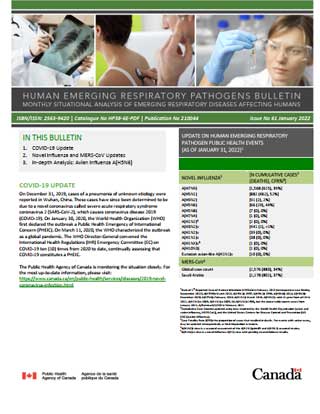Human emerging respiratory pathogens bulletin: Issue 61, January 2022
Download in PDF format
(1.1 MB, 3 pages)
Organization: Public Health Agency of Canada
Date published: 2022-02-08
Monthly situational analysis of emerging respiratory diseases affecting humans (data to January 31, 2022)
In this bulletin
- COVID-2019 update
- Avian influenza updates
- Swine influenza updates
- Middle East respiratory syndrome coronavirus (MERS-CoV) update
- In-depth Analysis: Avian influenza A(H5N6)
| Novel influenza Footnote 1 | Cumulative Case Count Footnote 2 | Deaths | Case Fatality Rate % Footnote 3 |
|---|---|---|---|
| A(H7N9) | 1,568 | 615 | 39% |
| A(H5N1) | 882 | 462 | 52% |
| A(H9N2) | 91 | 2 | 2% |
| A(H5N6) | 66 | 29 | 44% |
| A(H5N8) | 7 | 0 | 0% |
| A(H7N4) | 1 | 0 | 0% |
| A(H1N2) Footnote 4 | 2 | 0 | 0% |
| A(H3N2)v | 441 | 1 | <1% |
| A(H1N2)v | 39 | 0 | 0% |
| A(H1N1)v | 38 | 0 | 0% |
| A(H1NX)v Footnote 5 | 1 | 0 | 0% |
| A(H10N3) | 1 | 0 | 0% |
| Eurasian avian-like A(H1N1) | 10 | 0 | 0% |
| MERS-CoV Footnote 1 | Cumulative Case Count Footnote 2 | Deaths | Case Fatality Rate % Footnote 3 |
| Global Case Count | 2,576 | 880 | 34% |
| Saudi Arabia | 2,178 | 802 | 37% |
|
|||
COVID-19 update
On December 31, 2019, cases of a pneumonia of unknown etiology were reported in Wuhan, China. These cases have since been determined to be due to a novel coronavirus called severe acute respiratory syndrome coronavirus 2 (SARS-CoV-2), which causes coronavirus disease 2019 (COVID-19). On January 30, 2020, the World Health Organization (WHO) first declared the outbreak a Public Health Emergency of International Concern (PHEIC). On March 11, 2020, the WHO characterized the outbreak as a global pandemic. The WHO Director-General convened the International Health Regulations (IHR) Emergency Committee (EC) on COVID-19 ten (10) times from 2020 to date, continually assessing that COVID-19 constitutes a PHEIC.
The Public Health Agency of Canada is monitoring the situation closely.
Avian influenza updates
Avian influenza A(H9N2)
Five (5) new cases of avian influenza A(H9N2) were reported in January 2022, all from China. The cases range in age from 3 years old to 14 years old. Most (3/5; 60%) of the reported cases are female. They were reported from four (4) different provinces: Anhui, Jiangsu, Hubei, and Guangxi. All cases had history of poultry exposure prior to illness onset, developed mild illness, and had already recovered at the time of report.
Including these cases, 25 human cases of A(H9N2) developed illness in 2021, with the majority (24/25; 96%) of cases reported out of China. No cases have yet been reported that had illness onset in 2022. No cases have been reported in Canada. Since the emergence of this virus in the human population in 1998, 91 cases have been reported worldwide, with a case fatality rate (CFR) of 2%.
Avian influenza A(H5N1)
On January 6, 2022, the United Kingdom (UK) Health Security Agency (UKHSA) reported one (1) human case of avian influenza A(H5NX), which was later confirmed to be A(H5N1). This case was detected in southwest England. The case is over 70 years old, asymptomatic, and was non-infectious at the time of report. The case was exposed to A(H5N1) via infected domestic birds kept on the residence prior to illness onset. The birds were culled and the case was tested out of precaution. No onward transmission of the virus was identified through case contact follow-up.
In total, 882 human cases of A(H5N1) have been reported globally, with a CFR of 52%. Canada (Alberta) has reported one single fatal case of A(H5N1) in 2014, in a resident returning from travel in China. No cases have yet been reported in 2022.
Swine influenza updates
Swine origin influenza A(H1N2)v
The most recent cases of swine origin influenza A(H1N2)v were reported in November 2021 from the US and Canada.
Three A(H1N2)v detections have been reported in Canadian residents since reporting began in 2005. A total of 39 cases have been reported globally since 2005, with a 0% case fatality rate. There have been 11 A(H1N2)v cases reported globally in 2021.
Swine origin influenza A(H3N2)v
The most recent case of swine origin influenza A(H3N2)v was reported in October 2021 from the US.
Two A(H3N2)v detections have been reported in Canadian residents since reporting began in 2005, with the latest case reported in June 2021. Globally, 441 A(H3N2)v cases have been reported since 2005, with <1% case fatality rate. There have been 5 A(H3N2)v cases reported worldwide in 2021.
Swine origin influenza A(H1N1)v
On January 18, 2022, Denmark reported one (1) human case of swine origin influenza virus (subtype A/H1pdm09N1av-like) to the WHO. The case developed illness on November 23, 2021, after occupational exposure to swine. He was admitted to the ICU. No other cases were detected through case contact follow-up.
Two A(H1N1)v detections have been reported in Canadian residents since reporting began in 2005, with the latest case reported in April 2021. Globally, 38 human cases of A(H1N1)v have been reported since 2005, with no associated fatalities. There have been seven (7) A(H1N1)v cases reported worldwide in 2021 and one (1), including this case, reported in 2022.
Middle East respiratory syndrome coronavirus (MERS-CoV) update
The most recent cases of MERS-CoV were reported in December 2021 from the Kingdom of Saudi Arabia. Nineteen cases of MERS-CoV have been reported worldwide in 2021 [eight (8) of them fatal], with 17 of these cases reported from Saudi Arabia and two (2) from the United Arab Emirates. A total of 2,576 laboratory-confirmed cases of MERS-CoV, including 880 deaths, have been reported globally since 2012 by the WHO (CFR: 34%). No cases have been reported in Canada.
